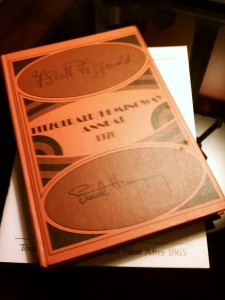
MLA Citation:
First Paragraph:
“In his influential book on Ernest Hemingway, Phillip Young contends that “there is little in Hemingway-and next to nothing of ultimate importance-that has not its precedents” in Mark Twain’s Huckleberry Finn. Young bases this claim on parallels that emerge from a comparison of Twain’s boy-hero Huck and Hemingway’s fictional heroes, but especially the prototype-hero Nick Adams as he appears in the story collection In Our Time. After a detailed and convincing presentation of similarities, Young concludes that Huck and Nick are nearly identical persons who are “very nearly twins.” Furthermore, says Young, “the adventures of the generic Nick Adams are the adventures of Huckleberry Finn in our time,’the main difference being only that “at the very point where Twain found his boy too complex, and let him go, Hemingway has exploited his condition, and raised him to complicated manhood.'” (136)
Summary:
Goldman traces the American composite hero from Huck FInn to Nick Adams to Seymour Glass. He argues that in the case of both Hemingway and Salinger the composite hero is presented first in a collection (In Our Time for Nick Adams and Nine Stories for Seymour Glass) which is then supplemented by that hero (or a similar character type under a different name) in additional stories. Goldhurst claims that “the Saga of the Salinger hero is a latter-day recapitulation of the Adventures of Nick Adams.” (138) Goldhurst sees all of the Glass family stories as part of this composite saga and even suggests that , “The Laughing Man,” “For Esme-With Love and Squalor,” and “Pretty Mouth and Green My Eyes” all fit into the Salinger composite hero’s saga. He makes an interesting and relevant assertion that Arthur, the pathetic protagonist of “Pretty Mouth and Green My Eyes,” can be seen as a pre-Lew figure, noting the logical progression from “uncle Wiggly in Connecticut” and as he goes on to suggest, “the adulterous wife of “Pretty Mouth” has developed into the alcoholic and neurotic wife of suburbia.” (140)
Goldhurst goes on to suggest that Salinger’s composite hero lives the typical cycle of experiences for his generation, what is unique is the Salinger hero himself who serves in the same tradition as Huck and Nick. On page 141, he asserts that the proper order for this composite hero’s cycle is as follows:
- Happworth 16, 1924
- The Laughing Man
- Seymour: An Intorduction
- The Catcher in the Rye
- Raise High the Roof Beam, Carpenters
- For Esme-With Love and Squalor
- Pretty Mouth and Green My Eyes
- A Perfect Day for Bananafish
- Zooey
Goldhurst details a umber of similarities not only in the heroes experiences but in the reactions of the heroes to their lived experience. Some similarities include the fact that both composite heroes come from middle class families, get punched, are eyewitnesses to violence who find it difficult to erase the memory of the gruesome violence that they witness. As they grow, both fight in European wars and suffer a nervous breakdown. Both embrace control in times of stress, both survive the war and have a hard time adjusting to civilian life. Both have “women trouble”, get married, and both turn to children for relief (Goldhurst notes that this theme is (of course) particularly well developed in Salinger’s stories).
After establishing that Salinger’s continuity with the prototype hero in Hemingway, Goldhurst moves onto a discussion of “Uncle Wiggly in Connecticut” as “an ironic and pessimistic continuation” of “The Three Day Blow.” (145) Goldhurst suggests that Hemingway’s “The Battler” was the inspiration for Salinger’s “Just Before the War With the Eskimos,” and that this is significant because we cannot understand the battler without and understanding of the role Huck Finn plays in the development of the story, similarly, we cannot realize the full effect of Salinger’s story without taking “The Battler” into account. (146-147)
*ed. note Harold Bloom’s Holden Caulfield deals with Salinger’s hero in terms of other American authors including Hemingway and Twain as well. This article is also cited in Lundquist’s book J.D. Salinger.
